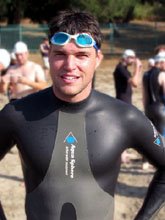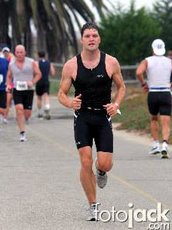 People ask me all the time, "Hey Andrew," they say, "how come you always work legs so hard with your clients, even if building leg strength isn't a priority to them? I mean, what gives?" (they always add the "what gives?"). "I mean, shouldn't you be giving your clients just what they want, and no more? What kind of trainer are you, anyway?"
People ask me all the time, "Hey Andrew," they say, "how come you always work legs so hard with your clients, even if building leg strength isn't a priority to them? I mean, what gives?" (they always add the "what gives?"). "I mean, shouldn't you be giving your clients just what they want, and no more? What kind of trainer are you, anyway?"Actually, no one has ever asked me that. Still, it's a valid question. Consider: unless you're a sprinter, cyclist, or competitive weightlifter, not too many people give a lot of thought to their leg strength. Sure, women are often concerned about toning their legs, but to that end most exercise programs suggest a leisurely regimen of leg extensions, leg curls, and leg-adductors (the seated movement where the exerciser squeezes the thighs together against resistance pads). And men will say, "Nah, I run, I don't need leg work, let's just hit the bench." And that's really it.
Few trainers or programs outlined in SHAPE will prescribe multiple sets of gut-busting variations on the squat, deadlift, and lunge the way I do. And as anyone who's ever done the exercises above will tell you, even the bodyweight-only versions of these moves are killers. Grab a couple of dumbbells in either hand or add an upper-body curl or press to the mix and they're next of kin to the interrogation techniques that George W. wishes he were still allowed to use.
Well, I'm here to tell ya it's not just sadism. I know that squats, deadlifts, and lunges hurt, believe me. I know you get out of breath when you do them, in the same way you get out of breath ascending stairs or steep hills on foot or on a bike (activities which accomplish much the same thing as the moves I'm talking about, for the gym-o-phobics among you). When you're not used to these moves, they can cause cramping in the calves and hamstrings; push it hard on these exercises and you'll get a nice little reminder of it every time you descend the stairs for a week.
But despite these disadvantages, whenever a client returns to me a few days after a hard leg workout, reeling like a newborn calf taking its first tentative steps, stumbling on legs that feel like they've been run over by a cement mixer, a warm feeling fills my heart. Because I know, deep in the marrow of my trainer-bones, that that person's metabolism has been on overdrive for the last few days, repairing the muscle tissue in their lower limbs. And if we keep working out, I know that that additional metabolic burn will become permanent, so that even if their diet remains unchanged, they will lose fat because of the muscle they've built in their legs. After their soreness subsides, climbing stairs, getting out of the car, indeed, any activity involving the legs, will become easier. Their core strength will improve. They will be better at any sport they happen to play. The connective tissues in the ligaments and tendons of their lower body will be stronger and more resistant to injury as they get older. To say nothing of the fact that their legs will just plain look better.
The fact is that working your legs with anaerobic (hard, soreness-inducing exercise) is the fastest way to burn fat that's out there. That's why all those cardio machines you see in the gym have you working your legs and not your brachoradialis. The musculature of your hips and thighs is the largest in your body, including the quadriceps (front of thigh), hamstrings (back of thigh) and glutes (that's your butt), and pushing them to the limit burns bucketloads of calories. Working them together, with multi-joint moves like squats and lunges, rather than separately, as with those useless leg-adductor machines, will elevate the heart rate and give you a peripheral cardiovascular workout as well. There’s evidence too that this type of move creates a generally anabolic (muscle-building) environment in the body, meaning that if you do these moves, they make everything else you do in the gym that much more effective.
That's why unless a client has some injury that prevents hard work in the lower limbs, sooner or later I always shove 'em over to the squat rack. No matter what the goal, you almost can't go wrong working the old pins. Want to lose some fat? Work your legs. Build a solid upper body? Work your legs. Get faster on the tennis court? Work your legs. Strengthen your joints? Work your legs. Develop telekinesis? Work your legs, then trade leg-training advice for enlightenment tips from a seventh-degree swami.
Not a bad return on an investment of a half-hour to forty-five minutes a week. So even if you have no interest in pounding out sets of squats with the brontosauri at Gold's, don’t shy away from Dead Man's Hill on your daily walk. Try to figure out ways of working some stair-climbing into your day. Push it hard up those hills and stairs, get the heart pounding and some sensation in your legs. That burn you feel is fitness gold.
Good luck, everyone.
Andrew




3 comments:
I now understand and appreciate -- mostly -- those *@%)$king squats and lunges we -- er, I -- do... all of a sudden burning quads aren't such a bad thing!
And who needs an adductor machine anyway?!?
"brontosauri at Gold's"!!!!!!! You are a funny writer. Great tips!
I have neglected my legs for so long but I start my legs and the whole body this week. So far so good.
Post a Comment